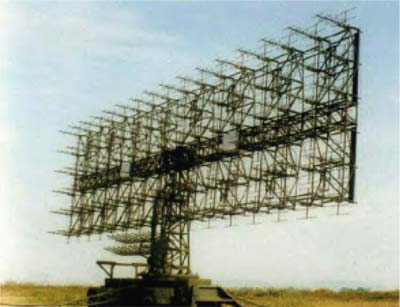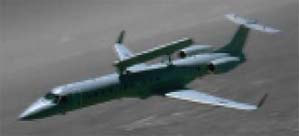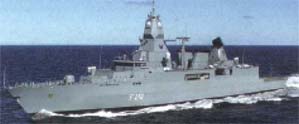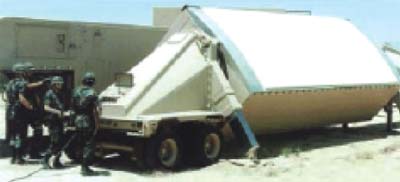Twenty years ago in Microwave Journal we wrote about “Radar in Transition.” The article opened with the statement that “radar engineers, at the end of 1984, find their field in transition between the conventional designs of the post World War II era and the digitally controlled, solid-state systems that will be in place for the year 2000.” We are now in a position to review that transition, consider the changes that have occurred and those expected in the future.
Air Surveillance
Air surveillance is carried out today, in systems other than Aegis and Patriot, with mechanically rotating antennas. Two-dimensional (2-D) radars for both military and civil systems use parabolic reflectors at L-band and above, or with arrays of dipole or Yagi elements in the VHF and UHF bands (see Figure 1). Power tubes (magnetrons, crossed-field amplifiers, or klystrons) predominate in the transmitters, as they did in 1980. A few systems have made the transition to multiple solid-state sources that are combined in an RF network for application to the duplexer and antenna.

Fig. 1 Chinese JY-27 solid-state VHF air surveillance radar.
Three-dimensional (3-D) radars use a variety of antenna types, most based on planar arrays but also including the unique array-fed reflector of the solid-state ARSR-4 radar (see Figure 2). The choice of that antenna design by the US Air Force and FAA was based on the need for circular polarization to cancel weather clutter. In wider use are arrays of slotted waveguides, combined in elevation beamforming matrices for stacked-beam 3-D operation, or scanned electronically in elevation by phase shifters or frequency-scan networks (and sometimes both). Slotted-waveguide arrays have been designed as ultra-low sidelobe antennas (ULSA) reducing vulnerability to ECM and, as in the E-3 AWACS radar, reducing the spectral spreading of ground clutter return. Power tubes predominate as RF power sources for these radars as well.

Fig. 2 ARSR-4 solid-state 3-D air surveillance radar (photo courtesy Northrop Grumman).
L-band arrays of dipole radiators, in which each row is fed by a solid-state T/R module, were developed in the late 1970s and continue in use today. The first to become operational was the AN/TPS-59, designed for the US Marine Corps to provide 3-D coverage to long-range applications. This radar scans a single beam electronically in elevation, while rotating mechanically in azimuth. The US Air Force adopted this design for the AN/FPS-117, variants of which are now in wide use. A different solid-state approach was chosen by Marconi for the stacked-beam Martello (see Figure 3), designed for the UK Royal Air Force and subsequently deployed around the world. Modules are used for each row of elements, but the transmitting beam is formed with the broad, cosecant-squared shape used in 2-D radars. Multiple receiving beams are generated within this sector by a beamforming matrix. Digital beamforming technology now finds one of its few practical applications in this type of radar, replacing the earlier analog networks.

Fig. 3 Martello solid-state 3-D air surveillance radar (photo courtesy Alenia Marconi Systems).
Airborne early warning (AEW) systems using arrays within rotating radomes have replaced the 1950s reflector systems. The primary examples are the E-2 radar at UHF and the E-3 at S-band. The former uses an electrically fixed array of Yagi-Uda radiating elements, which extend the electrical size of the aperture beyond the projected area of its radome, making it possible to operate a long-range AEW radar on a carrier-based aircraft. In spite of its low angular resolution, this radar meets requirements for Naval air warfare. Mounted on a modified 707 aircraft, the E-3 has a much larger radome containing a slotted-waveguide array that provides ULSA performance in azimuth and electronic scan in elevation to provide a horizon-stabilized beam with limited 3-D measurement capability. Power tubes are used in the transmitters of both these systems, and modern digital signal processing has been incorporated during modification programs to improve detection efficiency. The large US investment in the E-2 and E-3 radar systems has supported their deployment to NATO and several friendly nations. Russia has attempted, with only limited success, to replicate the E-3 performance in the Mainstay AWACS system. A major limitation of this type of AEW system is a data rate too low to maintain accurate track files on accelerating targets.
During the 1990s two AEW systems using fixed arrays with electronic scan were developed to provide AWACS capability for nations not choosing or qualified for the E-2 or E-3. Israel has developed a phased-array, L-band, conformal (PHALCON) system, using solid-state modules in arrays on each side of the fuselage. The Swedish Erieye (Ericsson Eye), shown in Figure 4, is another solid-state system, in which the array is embedded in a dorsal fin above the fuselage. Both these radars lack full coverage at nose and tail aspects, but Israel is correcting this by installing PHALCON arrays within a top-mounted Mainstay radome. The application of space-time processing, to improve doppler clutter filtering performance, is a major advantage associated with multiple-receiver modular arrays in airborne radar. Interlaced tracking at increased data rate is another advantage provided by electronic scan.

Fig. 4 Erieye airborne air surveillance radar (photo courtesy L.M. Ericsson).
Thus, the transition to planar arrays is well advanced in both surface and airborne air surveillance radars, at least for 3-D military systems. Many of these are electronically scanned in elevation using phase shifters, although stacked-beam systems provide superior clutter rejection and are preferred by those who can afford the complexity of multiple receivers and processors. Placement of T/R modules at each row of the arrays is today’s primary design approach. Active arrays with modules at each element have yet to find applications in surface-based air surveillance, although that class of system is dominant in large radars used for missile and space surveillance. Air traffic control continues reliance on 2-D radars with reflector antennas. Power-tubes remain competitive with solid-state devices as the source of RF power, but improvements in transistor efficiency, along with array designs favoring multiple, modular transmitters, can be expected to replace thermionic devices over the next decades.
Application of solid-state, electronically scanned arrays to AEW systems has been limited, due to the power-aperture advantage of arrays that exploit the maximum area at the center of a rotating radome, to provide uniform, 360° coverage. While this advantage could be replicated using rotating back-to-back active arrays with electronic azimuth scan to provide higher tracking data rates and space-time processing, that solution has so far eluded AWACS designers.
Anti-air Fire Control and Multifunction Radars
The US Army and Navy surface-to-air missile systems, Patriot and Aegis, were the first to deploy multifunction array radars (MFAR), and remain the largest users of this radar type. Both use phase scanning in two angular coordinates, with ~90° coverage from each array face. Patriot has a single array using a space-fed lens, mechanically oriented on the radar vehicle, and relies on multiple fire units to broaden coverage if necessary. Aegis places four corporate-fed planar arrays on each ship’s superstructure for 360° coverage. Both systems have undergone continuous evolutionary improvement, have been produced in large numbers and are planned to remain operational for decades in the future. Their main limitations are the need to use a compromise frequency band, too high for optimum search and too low for optimum guidance, and the problem of budgeting time for the multiple functions. The advent of active seekers in the higher microwave or millimeter-wave bands reduces the impact of the frequency compromise on tracking and guidance, and offers some relief in time budgeting.
Russian SAM systems have also exploited phased-array technology in SAM systems, but have applied it to multiple-target fire control radars in the bands best suited to this function (X-band for long range, Ku-band for shorter range), relying on separate radars for volume search. The arrays are space-fed lenses or reflectors, in which elements with some end-fire gain are used to reduce cost, restricting the scan field but minimizing the grating lobes that result from greater spacing between elements. A feature of these radars is their ability to apply medium and high PRF pulsed doppler waveforms for clutter rejection, through the use of reciprocal phase shifters whose settings are changed only when a new scan angle is needed, rather than during each pulse repetition interval.
Along with the US Patriot, the Russian Flap Lid and Tombstone fire control radars (see Figure 5) have experienced the largest production of any phased-array system, and can be expected to maintain this numerical status into the next decades. Export of the Patriot is limited primarily by its cost and US export policy. The proliferation of SA-10 and its variants has been slow, because of cost and possibly also because of customer concerns over future maintenance support of the system.

Fig. 5 Tombstone fire control radar (D. Barton photo from 1993 Moscow Air Show).
Aegis is available to nations where its use is approved by the US, such as Spain and Norway, but faces competition by no fewer than three European systems, each using a multifunction or multiple-target phased-array tracker supplemented by an L-band surveillance radar. The UK has equipped its Type 45 destroyer with the S-band Sampson solid-state array, derived from the earlier Mesar radar. France and Italy prefer the C-band Empar, powered by a traveling-wave tube. Both radars place their arrays in radomes rotating mechanically at 30 rpm, and the use of back-to-back arrays provides Sampson with at least two track points per scan, increased to four if beams at ±45° from broadside are scheduled. Germany and The Netherlands use the X-band APAR multitarget tracker with the L-band Smart-L 3-D radar to provide surveillance and target designation (see Figure 6). The APAR can cover 360° with three or four fixed faces, offering complete flexibility in track update rates as well as illumination in support of semiactive terminal guidance for Sea Sparrow missiles. A new US system, designated AN/SPY-3, also includes X-band, solid-state T/R modules, supplemented by a lower frequency surveillance radar. It is likely that all these naval systems will see continued use in the next two decades, although it remains to be seen which will survive competitive pressures.

Fig. 6 German F124 frigate, equipped with APAR fire control radars on the forward superstructure and Smart-L surveillance radar aft (photo from January 2003 JED).
Airborne Multipurpose Radars
The application destined to rely on a single antenna aperture is the fighter/attack aircraft radar, where one nose radome location is available for all functions. This class of radar is now required to perform the traditional airborne intercept role with medium or high PRF waveforms, along with air-to-surface targeting (using both doppler beam-sharpening and spotlight mapping techniques), terrain avoidance, noncooperative target recognition, and other modes for navigation and refueling rendezvous. Mechanically scanned antennas using flat-plate arrays of slotted waveguide are used today throughout the world for this type of radar. The alternative of a polarization-twist system, in which a fixed horn and parabolic reflector illuminate a mechanically tilted flat reflector, appears in some Russian, French and Israeli systems. One electronically phase-scanned array was placed in limited service by the Russian Air Force, but this and the B-1 bomber radar are the only examples of this type of airborne radar. Traveling-wave tubes have provided the power for virtually all airborne systems.
Current airborne radar development is concentrated on active, electronically scanned arrays (AESA) using X-band solid-state modules for each element. The work started decades ago by Texas Instruments on this technology has evolved to the point where practical designs are appearing in Europe as well as the US. Deployment in new types of fighter-attack aircraft has begun, along with retrofit onto existing aircraft. The need for rapid transition among multiple targets and operating modes provides a strong incentive for transition to electronically scanned arrays, and the advantages in weight and reliability strongly favor the active modular approach for these arrays. Given the high cost of modern aircraft, radar cost is not the determining factor in procurement.
To date, AESA developments such as the AN/APG-77 for the F-22 have used modules in which the inputs and outputs are at RF, with RF beamforming networks feeding three-channel monopulse receivers and supplementary sidelobe suppression channels. The new arts of digital beamforming and space-time processing, however, require that individual modules contain the downconversion, IF amplification and analog-to-digital conversion portions of the receiving system. This adds significantly to the cost and complexity of the modules, representing a new challenge in producibility along with the upward step in performance. When combined with the interest in wider bandwidth operation and reduction in emitted sidelobe levels, to minimize vulnerability of signals to intercept, the airborne radar designer is faced with stressful decisions in balancing performance against efficiency, complexity and cost. What is easy to demonstrate in computer simulations becomes more difficult in hardware intended for large-scale production. The next decade will show how this conflict is to be resolved in airborne radars.
Anti-ballistic Missile Radar
Almost fifty years of development was invested in anti-ballistic missile (ABM) radar systems that were deployed either in small numbers or not at all. Ballistic missile early warning systems (BMEWS) are operated by both the US and Russia, using huge mechanically or electronically scanned antennas. Fire control and interceptor guidance radars were also deployed in small numbers. The Patriot system (originating from the early Army study for FABMDS, the Field Army Ballistic Missile Defense System) was designed to include tactical ballistic missiles in its target set, and saw use in that role during the first Gulf War (with results that remain controversial). The Russian SA-12 SAM system was designed to engage tactical and short-range ballistic missiles as well as aircraft, and was tested against both types of target. The system included a specialized X-band sector-scanning radar for missile detection, operating at ~20 kW average power with ~20,000 passive phase-shifting elements in a space-fed lens.
During the 1990s, a new approach to a field army ABM radar appeared, in the form of an X-band active modular array, designated the Ground-based Radar (GBR) and later the Theater High Altitude Area Defense (THAAD) radar (see Figure 7). The initial version of this radar used a thinned array of some 25,000 elements with ~50 kW total average power, numbers that were planned to increase by a factor of three in a fully filled array. Even larger radars are scheduled for use in the continental defense system. The technology used in these radars was derived directly from the X-band module program originally intended for airborne radars. Application of the Aegis system and the AN/TPS-59 3-D air defense radar to ballistic missile defense is also planned. Thus, other than implementation of new waveforms, the technology of ABM radar follows from that of surface-based and airborne military radar, with scaling of antenna size, total transmitter power and cost.

Fig. 6 THAAD ground-based radar (photo courtesy Raytheon Co.).
Surface, Battlefield and Homeland Surveillance
The preceding discussions have not considered many major applications such as maritime navigation, battlefield surveillance, hostile battery location, minefield detection, drug enforcement and many civil or scientific uses of radar. The variety of requirements makes it difficult to summarize, generalize, or project the state of the art in these areas. Common technology for use in all of these applications, however, involves solid-state RF generation, miniaturized receivers and refined digital signal processing. The RF technology has been driven largely by the programs for air and missile defense, and the receiver and digital technology by commercial developments.
Projections
The transition predicted twenty years ago has proceeded more slowly than expected, as radar users maintain and upgrade their legacy systems. Solid-state modular array technology has proven expensive, and radar designers have found it difficult to attain the high power-aperture products required for long-range surveillance. AESA technology appears most successful in the field of multipurpose airborne radar, where the available aperture area is limited to less than one square meter. The number of array elements is then less than 2,000 at X-band, keeping radar cost within the budgets of new fighter/attack aircraft programs. The flexibility of the AESA in performing the many tasks assigned to the airborne radar encourages its use. Future challenges will be to incorporate into hardware the exotic space-time adaptive processing technology whose effectiveness is shown in computer simulations, and to achieve adequate power-aperture product for use in air-to-air operations against targets having low cross section in microwave bands.
Modular array technology will also find its place in surface-based fire control radars, where it has already demonstrated its potential in the APAR and THAAD systems. These same X-band modules, produced in large quantities, should become economical enough to appear in tactical systems. The APAR shows that arrays with low power-aperture products can be successful in the multitarget air-defense tracking role, when combined with adequate surveillance radars operating at lower frequencies.
Surveillance radar technology will change more slowly, since it requires large power-aperture products and longer beam dwells with sophisticated signal processing to meet detection requirements on reduced target cross sections in cluttered environments. The advantages of the lower radar frequency bands are clear, and as solid-state devices attain higher efficiencies and power levels they will supplant tubes as RF sources. Rotating arrays remain advantageous for both surface-based and airborne air surveillance, although in some naval applications fixed, multiple-face arrays may prove easier to integrate into the design of superstructures having reduced radar cross section. Attention will be needed to reduction of the thermal signature when AESAs are used in this application.
In air traffic control, radar will have to compete with cooperative systems using onboard GPS navigation and reporting via radio link. Recently discovered requirements to maintain surveillance on uncooperative aircraft may delay the inevitable change to GPS-based systems, at least in the US and other regions concerned about terrorist attacks.
